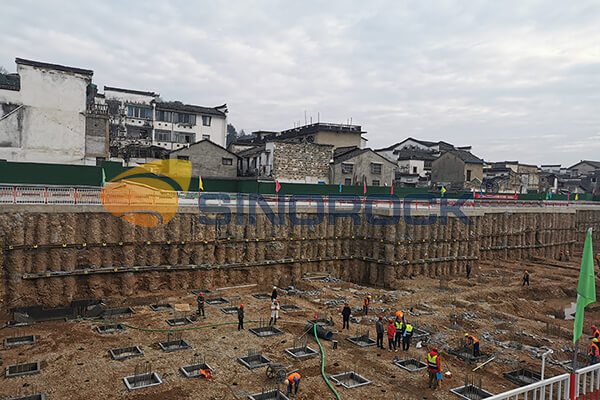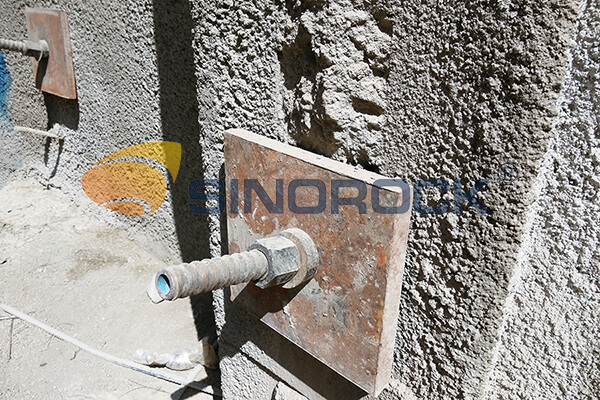Advantages of self-drilling soil nails VS solid soil nails
Time:2024-01-03From:sinorock View:
Introduction to Self-Drilling Soil Nails and Solid Soil Nails
In the realm of foundation pit support technology, the use of soil nails has emerged as a transformative approach, offering innovative solutions for in-situ soil reinforcement. Traditionally, soil nailing involves the installation of slender rods through drilled holes in the soil, relying on interfacial bonding forces or friction between the soil and the soil nail. The traditional soil nailing support is passive support, and the soil nails are only stressed after the soil body deforms to a certain extent, so generally no prestress is applied. Therefore, traditional soil nailing is not suitable for loose geological conditions such as water-rich silt-fine sand layer, gravel pebble layer and silty soil. The self-drilling hollow bolt produced by Sinorock has strong anti-pulling performance and good connection with the soil. It can replace solid soil nails such as steel bars, and is suitable for various geology.

Explanation of Self-Drilling Soil Nails
Definition and Purpose
Sinorock's ground-breaking technology, exemplified by its self-drilling soil nails, represents a revolutionary approach to foundation pit support. These unique soil nails are hollow bolts that are designed to drill, grout, and anchor simultaneously, providing an efficient and versatile in-situ soil reinforcement solution for a wide range of geological conditions.
Advantages over Traditional Solid Soil Nails
The advantages of self-drilling soil nails over their traditional solid counterparts are manifold, ushering in a new era of construction efficiency and effectiveness. Let's delve into the specific merits that set self-drilling soil nails apart.
Advantages of Self-Drilling Soil Nails

Time and Cost Efficiency
Elimination of Pre-Drilling Process
One of the most notable advantages of self-drilling soil nails is the elimination of the pre-drilling process. Unlike traditional soil nailing, where pre-drilling is a prerequisite, self-drilling soil nails streamline the construction process by integrating drilling, grouting, and anchoring into a single, efficient operation.
Faster Installation
The integration of drilling and grouting into a seamless process significantly accelerates the installation of self-drilling soil nails. The one-step operation minimizes downtime, allowing for swift project progression and reducing overall construction time.
Reduced Labor and Equipment Requirements
The simplicity of the self-drilling process translates into reduced labor and equipment requirements. With no need for extensive pre-drilling and additional equipment, construction teams can achieve more with fewer resources, contributing to cost savings.
Increased Flexibility and Adaptability
Suitable for Various Soil Conditions
Self-drilling soil nails exhibit exceptional adaptability to a diverse range of soil conditions. Traditional soil nailing faces challenges in loose geological conditions such as water-rich silt-fine sand layers and gravel pebble layers. In contrast, self-drilling soil nails can thrive in these challenging environments.
Easy Installation in Confined Spaces
The design of self-drilling soil nails allows for easy installation in confined spaces. This flexibility enables construction projects in areas where traditional soil nailing may be impractical or impossible.
Ability to be Installed at Different Angles
Self-drilling soil nails offer the versatility of installation at various angles, catering to the specific needs of each construction project. This adaptability enhances their applicability in complex geological scenarios.
Improved Performance and Durability
Enhanced Bond Strength with Surrounding Soil
The innovative design of self-drilling soil nails promotes enhanced mechanical adhesion with the surrounding rock and soil. This heightened bond strength ensures the effectiveness of the support system, even under challenging geological conditions.
Minimized Risk of Corrosion
Solid soil nails, particularly in corrosive environments, are susceptible to corrosion over time. Self-drilling soil nails, with their advanced materials and construction, minimize the risk of corrosion, ensuring long-term durability and reliability.
Higher Load-Bearing Capacity
The self-drilling hollow bolt, a hallmark of Sinorock's technology, boasts strong anti-pulling performance. This feature, combined with its superior connection with the soil, results in a higher load-bearing capacity compared to traditional solid soil nails.
Environmental Benefits
Reduced Noise and Vibration During Installation
Construction projects often entail environmental concerns, including noise and vibration. Self-drilling soil nails make less noise and vibration during installation compared to traditional solid soil nails, contributing to a more environmentally friendly construction process.
Decreased Soil Disturbance and Excavation
Traditional soil nailing methods may involve significant soil disturbance and excavation. Self-drilling soil nails minimize these disruptions, making them an eco-friendly choice that aligns with sustainable construction practices.
Possibility of Reusing Nails in Future Projects
The versatility of self-drilling soil nails extends beyond their initial use. In some cases, these nails can be safely removed and reused in future projects, further optimizing resource utilization and minimizing waste.
Comparison with Solid Soil Nails
Explanation of Solid Soil Nails
Soil nails are slender rods used to reinforce or simultaneously anchor the in-situ soil at the site. They are usually formed by drilling holes in the soil, inserting deformed steel bars, that is, ribbed steel bars, and grouting along the entire length of the hole. The soil nail relies on the interfacial bonding force or friction force between the soil body and the soil body to passively bear the force under the condition of the soil body deformation, and mainly bear the tensile force. These traditional soil nails only come into play after the soil deforms to a certain extent, and no prestress is applied during installation.

Drawbacks and Limitations of Solid Soil Nails
The limitations of solid soil nails become apparent in specific geological conditions, such as water-rich silt-fine sand layers, gravel pebble layers, and silty soil. Traditional soil nailing struggles in these loose geological conditions, making it unsuitable for a broad spectrum of construction scenarios.
Conclusion
The streamlined one-step operation, adaptability to various soil conditions, improved performance and durability, and environmental benefits position self-drilling soil nails as a superior choice over traditional solid soil nails.
As an effective anchoring product, Sinorock Self-drilling Hollow Bolt has been widely used in advanced support, radial support, slope support, foundation pit support, roadway support, various surrounding rock support projects such as soil nailing support have been widely praised by the industry. If you have any needs or questions about the self-drilling anchor bolt system and its application, please feel free to contact us at sinorock@sinorockco.com.
latest news
-

- 3 Crucial Factors That Impact the Quality of Self-Drilling Hollow Bolts
- Time:2025-01-26From:This Site
- As we all know, the quality of the self-drilling hollow bolts is vital to the whole project. It determines if the project is safe for the people in future use. Then, what will affect the quality of the self-drilling hollow bolts?
- View details
-

- Self-Drilling Anchor Bolt Construction in Complex Geological Slope
- Time:2025-01-24From:This Site
- During construction, Self-drilling hollow anchor bolt integrates drilling, grouting and anchoring functions, which significantly improves drilling efficiency. And under the action of pressure pump, the grouting in the rock strata and voids is full, which ensures the grouting thickness and anchoring effect.
- View details
-

- How Does Self-drilling Rock Bolt Drill in Quicksand Geological Condition?
- Time:2025-01-19From:This Site
- This in-depth guide explores how self-drilling rock bolts function in quicksand geological conditions, covering the challenges, construction methods, and best practices for ensuring effective anchorage in unstable, fluidic soil layers.
- View details
-

- Quality Control: the Vital Factor of A SDA Bolt Factory
- Time:2025-01-09From:This Site
- Sinorock’s comprehensive quality control system, from supplier management to outgoing inspections, ensuring the highest standards for self-drilling anchor bolts in construction.
- View details
-
.png)
- International Women's Day with Strawberry-picking
- Time:2024-03-09From:This Site
- Marked the annual observance of International Women's Day, and to commemorate this significant event, Sinorock organized a special strawberry-picking event exclusively for its female employees.
- View details
-

- Celebrate the 74th anniversary of the founding of the People's Republic of China
- Time:2023-10-01From:This Site
- On October 1st every year, we observe the annual National Day, commemorating the birth of our beloved motherland.
- View details
-
.jpg)
- SINOROCK to Attend EXPOMINA PERÚ 2024 in Lima, Peru
- Time:2024-08-10From:This Site
- Sinorock to Attend EXPOMINA PERÚ 2024 in Lima, Peru
- View details
-
.jpg)
- SINOROCK to Participate in MINING AND METALS CENTRAL ASIA 2024
- Time:2024-08-08From:This Site
- SINOROCK to Participate in MINING AND METALS CENTRAL ASIA 2024
- View details
-

- SINOROCK Gears Up for UGOL ROSSII & MINING 2024 with Custom Mining Solutions
- Time:2024-05-15From:This Site
- SINOROCK is thrilled to announce its participation in the highly anticipated 32nd International Trade Fair for Mining Technology, UGOL ROSSII & MINING 2024. The event will take place at the Exhibition complex "Kuzbass Fair" in Novokuznetsk, Kemerovo region - Kuzbass, Russia, from June 4th to 7th, 2024.
- View details
 Download
Download 


